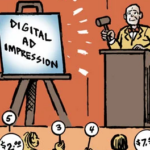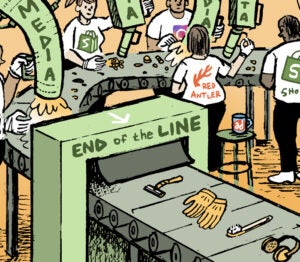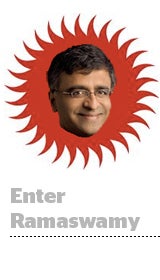 It’s been nine months since Susan Wojcicki was named CEO at YouTube, clearing the path for Sridhar Ramaswamy to take full control of Google’s $50 billion-plus advertising business.
It’s been nine months since Susan Wojcicki was named CEO at YouTube, clearing the path for Sridhar Ramaswamy to take full control of Google’s $50 billion-plus advertising business.
As org changes go, it was a doozy. YouTube would get a proven leader to take it to the next level – by investing in talent and courting new audiences outside its core millennial user. Additionally, YouTube advertising would begin reporting into the display ad group. All Google ads (search, display, YouTube) would live under one umbrella for the first time.
The guy holding that umbrella, Ramaswamy, is an executive whose methods and management style contrast sharply with Wojcicki. Numerous sources describe him as a highly technical executive, and far more hands-on than she ever was.
Indeed, the obsession with details exhibited by Ramaswamy and his handpicked lieutenants has rankled some senior technical staff. Joerg Heilig, for many years Google’s top engineer on display ads, left earlier this year over differences with Ramaswamy. And others are said to be looking as well.
Not everyone is grumbling, however. By multiple accounts, Ramaswamy has a good relationship with Neal Mohan, Google’s high-profile VP for display ad products. He has largely endorsed Mohan’s product vision, even as that vision continues to evolve.
Two Leaders, One Organization
Ramaswamy and Wojcicki previously shared responsibility for both the advertising and commerce businesses at Google. They had the same title – SVP, ads and commerce – and many of the same values. For instance, both are strongly focused on ad quality and the user experience.
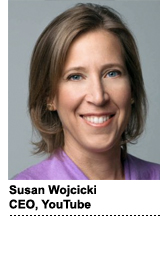 But Wojcicki was the public face of advertising at the company, and it was her management style that prevailed.
But Wojcicki was the public face of advertising at the company, and it was her management style that prevailed.
She had a strong and relatively hands-off relationship with her two key direct reports: Mohan and Heilig. Mohan ran the product side, whereas Heilig was the SVP of engineering.
With Wojcicki, the two men were left to run many facets of the business as they saw fit. But with Ramaswamy, it was different.
As with many of Google’s top management team, Ramaswamy has an elite pedigree. He earned a Ph.D. from Brown University and held technical roles at Bell Labs and Epiphany in the 1990s before joining Google as an engineer in 2003. Once there he was rapidly promoted through a series of senior engineering roles based on his successful work on AdWords, Google Shopping and payment products.
According to sources, Ramaswamy is far more engaged in the details of product development and engineering than his predecessor. As new leaders often do, Ramaswamy has brought his own senior engineering team. Scott Silver and Eisar Lipkovitz, both with the title VP for engineering, were his chosen guys.
Together, the three men have conducted a thorough “research” process running across the Google and DoubleClick product families.
Turmoil In Engineering
The appointment of Ramaswamy’s lieutenants, Silver and Lipkovitz, coincided with the exit of Heilig, Mohan’s engineering counterpart and for many years the senior authority among Google’s technical team working on display products. The two men essentially split Heilig’s job.
Why did Heilig leave? Sources describe him as a very technical talent who “didn’t get along” with Ramaswamy, who is himself seen as a “genius” at systems thinking. (Wojcicki, by contrast, seems to have given Heilig a wider berth and more room to breathe.) For Heilig, the additional oversight may have felt like a demotion.
Whatever the specific cause of friction, Heilig left the display ads group in May – around when Lipkovitz was brought in. He now works on Google’s cloud platform.
 Ramaswamy’s arrival and Heilig’s transfer seems to have been harrowing for some on the engineering team, as multiple product leads were forced to “justify their existence,” as one source put it. As a result, some are casting around for new jobs.
Ramaswamy’s arrival and Heilig’s transfer seems to have been harrowing for some on the engineering team, as multiple product leads were forced to “justify their existence,” as one source put it. As a result, some are casting around for new jobs.
One senior exec at an early-phase ad tech startup described interviewing two Google ad engineers who are seeking opportunities. Isaac Payam Ahdout, a seven-year Google employee and engineering manager on DFP and AdX, recently left for TapAd, where he is now SVP for engineering. Ahdout did not respond to a request for comment.
Of course, with an ad product team as big as Google’s – the company employs roughly 2,000 engineers focused on advertising alone – a handful of departures does not necessarily imply a problem. On the other hand, Google is famous for its ability to retain product talent, so any senior exits are at the very least notable.
Not everyone interviewed for this story said the environment had become unpleasant for engineers. “It’s true that he’s more engaged in the details than Susan was,” according to one source, before adding that Ramaswamy and his team simply needed to educate themselves.
“Yeah, Sridhar has a different style than Susan, and yeah, he’s asking difficult questions,” the person said. “He just wants to understand the makeup of the team, he wants to understand the product.”
Product Transformation
Successful Internet companies evolve quickly, and Google may have set the bar in this regard. No surprise then that some recent developments in its ad business have little to do with Ramaswamy’s arrival. For instance, a yearslong effort to integrate some overlapping products – including merging DoubleClick for Publishers (DFP) and DoubleClick Ad Exchange (AdX) – has been affirmed by Sridhar and will go forward as planned.
Since it began piecing together its display ad platform around 2007, Google has assembled an astonishing array of products – many overlapping. To name a few: AdWords, DoubleClick For Advertisers, DoubleClick Campaign Manager, DFP, AdX, Google Display Network, AdSense, Admob, DoubleClick Bid Manager (formerly Invite Media) and Wildfire (social media marketing).
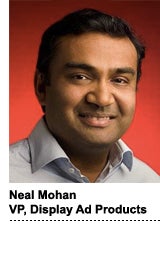 Back when Ramaswamy and Wojcicki jointly ran the ads group, there was an acknowledgement within Mohan’s group that some products should be merged into others. DFP and AdX in particular had heavy customer and feature overlap, and yet functioned as separate products with separate leaders and development cycles. Publisher customers wanted a fix.
Back when Ramaswamy and Wojcicki jointly ran the ads group, there was an acknowledgement within Mohan’s group that some products should be merged into others. DFP and AdX in particular had heavy customer and feature overlap, and yet functioned as separate products with separate leaders and development cycles. Publisher customers wanted a fix.
“The idea was that there shouldn’t be two reporting interfaces that are totally different,” said one source. “If you look at the sales side, or the business side, they’re integrated. The people who support AdX and DFP are the same.”
It was decided the product teams should converge. As an outcome of this decision, DFP boss Jonathan Bellack was picked to lead a unified DFP/AdX product, reporting to Mohan. Scott Spencer, director of product management in charge of AdX, would report to Bellack. That org change took effect earlier this year, but the integration is still a work in progress.
Ramaswamy and Wojcicki had both signed off on this plan, but the progress was slowed down over the summer so the new leadership team could do its review and get up to speed. Later, Silver and Lipkovitz took their feet off the brake pedal and the product plans gained velocity again.
Data Policy
Outside observers say they see a different Google shining through in other ways. For example, many in the industry were surprised by Google’s decision to prevent standalone data-management platforms from firing tracking pixels on the Google Display Network unless they also owned a demand-side platform to bid on the impression.
 Additionally, Google has lately shown itself open to new monetization ideas – including a subscription model for YouTube and a program called Contributor that would let users receive an ad-free experience on certain sites by making monthly contributions. Which, if any, of these changes reflect the hand of Ramaswamy?
Additionally, Google has lately shown itself open to new monetization ideas – including a subscription model for YouTube and a program called Contributor that would let users receive an ad-free experience on certain sites by making monthly contributions. Which, if any, of these changes reflect the hand of Ramaswamy?
“It certainly does feel like there’s a new regime,” said one senior agency executive, who, like other sources for this story, requested anonymity.
He added, “The way you build a market, and then the way you scale it once it becomes dominant, are different things. Google may have been throwing things at the wall a year ago or five years ago and figuring out what works.”
Today, by contrast, the company is streamlining.
What about Mohan?
One question swirling through these changes is whether Mohan will stick around at Google. He’s been in charge of Google’s display ambitions for going on a decade, and has privately told colleagues that he has no plans to leave.
However Mohan has shown he is open to outside offers. As Michael Arrington described in a TechCrunch post, Google successfully blocked Twitter’s 2011 attempt to poach Mohan by countering with $100 million in stock, a sweet retention bonus that “could be called an IQ test,” as Arrington put it. Google pays engineering and product management very well.
And yet, said one former colleague, “It’s possible he may ask himself, how much money does one person actually need?”
These days Mohan spends significant time focused on YouTube’s ad products, so he’s still in close contact with his old boss. The opportunity to invent the future of digital video advertising would seem to be keeping him engaged.
And Mohan gets on well with Ramaswamy too. Ramaswamy’s technical knowledge makes him a good thinking partner to Mohan, fueling product innovation and go-to-market strategy.
Mohan, the face of Google display advertising, seems willing to stay put for now.



